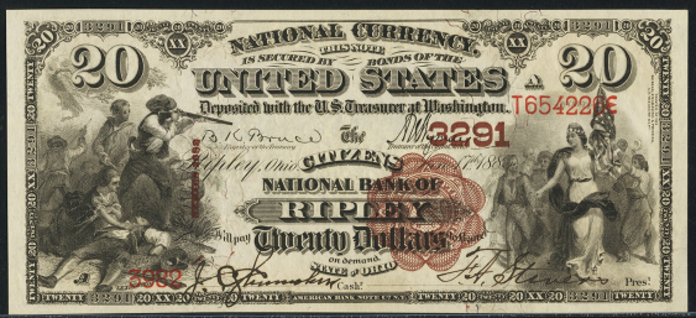Twenty Dollar Notes › Nationals › 1882 Twenty Dollar National Bank Notes › Pennsylvania Charters › 1882 $20 Kittanning Pennsylvania National Bank Of Kittanning
Get Value Now
| Item | Info |
|---|---|
| Series | 1882 |
| Charter | #2654 National Bank of Kittanning of Kittanning, Pennsylvania |
| Year Chartered | 1882, 243 Banks Chartered |
| City Info | Kittanning is a borough and the county seat of Armstrong County in the U.S. state of Pennsylvania. It is situated 44 miles northeast of Pittsburgh, along the east bank of the Allegheny River. The name Kithanink means 'on the main river' in the Delaware language, from kit- 'big' + hane 'mountain river' + -ink. "The main river" is a Lenape epithet for the Allegheny and Ohio, considered as all one river. The borough and its bridge were used as a setting for several recent films. Source: Wikipedia |
| Similar Cities | If your note doesn't match try: 1. Kittanning, Pennsylvania - First National Bank 2. Kittanning, Pennsylvania - Kittanning National Bank 3. Kittanning, Pennsylvania - Farmers' National Bank 4. Kittanning, Pennsylvania - Merchants' National Bank |
| Seal Varieties | Brown, Blue |
| See Also | If your note doesn't match try: 1. 1882 $20 Gold Certificate 2. 1878 $20 Legal Tender 3. 1880 $20 Legal Tender |
| Other Info | 1. Value depends on notes known for charter, condition and market demand. |
| Neat Fact | 1-5 Digit Charter number critical to note identification. It is Red, Blue, Black or rarely absent altogehter. It is printed over the note design. |
No Obligations Offers and Appraisals
Please submit a good photo or scan. It will be identified and evaluated. Understand there may be subtle differences between the image you see above and your note. Signatures, design, markings and note condition will determine the offer price. Notes in Uncirculated or better condition receive the best offers.
Appraisals can be estimated for wholesale and retail prices. Wholesale is what dealers typically pay. Retail is what a collector might pay. Retail is slightly higher in most cases.
Please visit this page for USA Paper Money Reference. Do not treat this page as a reference guide, it is for appraisal and acquisition purposes only.
